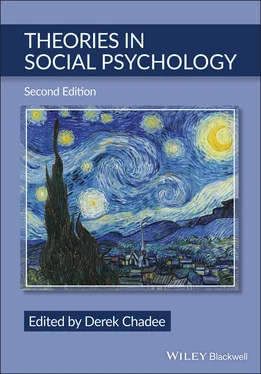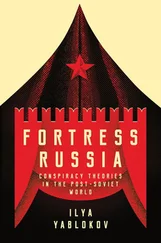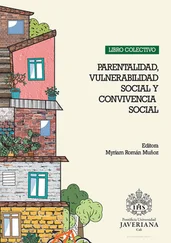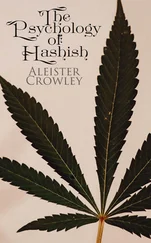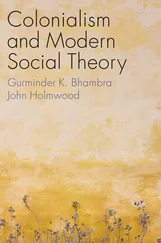Theories in Social Psychology
Здесь есть возможность читать онлайн «Theories in Social Psychology» — ознакомительный отрывок электронной книги совершенно бесплатно, а после прочтения отрывка купить полную версию. В некоторых случаях можно слушать аудио, скачать через торрент в формате fb2 и присутствует краткое содержание. Жанр: unrecognised, на английском языке. Описание произведения, (предисловие) а так же отзывы посетителей доступны на портале библиотеки ЛибКат.
- Название:Theories in Social Psychology
- Автор:
- Жанр:
- Год:неизвестен
- ISBN:нет данных
- Рейтинг книги:5 / 5. Голосов: 1
-
Избранное:Добавить в избранное
- Отзывы:
-
Ваша оценка:
- 100
- 1
- 2
- 3
- 4
- 5
Theories in Social Psychology: краткое содержание, описание и аннотация
Предлагаем к чтению аннотацию, описание, краткое содержание или предисловие (зависит от того, что написал сам автор книги «Theories in Social Psychology»). Если вы не нашли необходимую информацию о книге — напишите в комментариях, мы постараемся отыскать её.
—Robert J. Sternberg,
—Phillip G. Zimbardo, Ph.D., Theories in Social Psychology
Theories in Social Psychology, Second Edition,
Theories in Social Psychology — читать онлайн ознакомительный отрывок
Ниже представлен текст книги, разбитый по страницам. Система сохранения места последней прочитанной страницы, позволяет с удобством читать онлайн бесплатно книгу «Theories in Social Psychology», без необходимости каждый раз заново искать на чём Вы остановились. Поставьте закладку, и сможете в любой момент перейти на страницу, на которой закончили чтение.
Интервал:
Закладка:
Dillard and Shen (2005) utilize a composite of self-report indices of anger and negative cognitions to measure psychological reactance. This intertwined model integrates the cognitive and affect in understanding reactance and was one of the first meaningful attempts to measure state reactance. Reactance researchers (e.g., Quick et al., 2015; Clayton et al., 2019; Kim et al., 2013; Rains & Turner, 2007; Scott & Quick, 2012; Xu, 2015) have utilized Dillard and Shen (2005) composite index to measure psychological reactance in varying contexts. Their scale is one of the most used reactance scales. Lindsey (2005) constructed a scale to understand the influence of guilt in bone-marrow donation. However, as Quick (2012) notes, her scale has been utilized by reactance researchers. Lindsey’s scale was informed by Brehm (1966) and Hong and Faedda (1996) and has four items modified from Hong and Faedda (1996) to measure state reactance instead of trait reactance. Her scale has been utilized in the literature (see LaVail et al., 2010; Reinhart & Anker, 2012). Quick’s (2012) article provides a comparison between Lindsey’s (2005) and Dillard and Shen (2005) scales. In an attempt to create a scale to measure state reactance Sittenthaler et al. (2015) undertook three studies to develop the Salzburger State Reactance scale (SSR). They identified three subscales in the SSR, namely experience of reactance, aggressive behavioral intentions, and negative attitudes. The scale has nineteen original items with responses to each item varying from “not at all” to “very much” on a five-point Likert scale.
The Crowell Lowery Multicultural Training Reactance Scale (CL-MTRS) is a relatively new scale attempting to measure students’ psychological reactance in a specific context (see Lowery et al., 2020). The scale utilizes 22-items to measure psychological reactance toward multicultural training experience. Cognitive, behavioral, and affective evaluations of the training experience, including course topics, facilitator, and processes, are measured (see Kelly et al., 2019).
Cognitive Dissonance and Reactance
To what extent is psychological reactance the same as cognitive dissonance? Do we always experience cognitive dissonance when we experience reactance? There are a number of commonalities between psychological reactance and cognitive dissonance. Both theories are motivational arousal theories emphasizing cognitive evaluation and gravitation toward psychological consistency. Arousal is a noxious state in both cognitive dissonance and psychological reactance theories, and a drive is buildup-directed to achieve a state of equilibrium (consonance or removal of threat to freedom). The importance of the cognition or threatened freedom determines the degree of cognitive dissonance or psychological reactance, respectively.
Several strategies are used to obtain equilibrium, and these methods vary from cognitive to behavioral to emotional changes. The reevaluation of importance, changing or adding new cognitions, adoption of new behavior, or changing existing behaviors are some of the common strategies of arousal reduction adopted by both theories. Neither theory is set up to be scientifically falsified, and therefore, in that sense, they cannot be considered scientific theories. Also, both theories are parsimonious. The difference in parsimoniousness is one of degree. However, there are some major differences.
Although both theories state that arousal is unpleasant, in the case of reactance the unpleasantness is always associated with negative emotions, unlike dissonance, in which both positive and negative emotions can be experienced. Sources of arousal are different: reactance involves a threat associated with a freedom, and therefore there is a “victim” and “victimizer” interaction, an externally social threatening factor, which is not the typical cognitive dissonance scenario. Therefore, there is a narrower scope of the application of reactance theory as compared to cognitive dissonance.
Wicklund (1974) was one of the first authors to attempt to address the issue of overlaps between the theories of dissonance and reactance. He argues that as far as decision making is concerned, cognitive dissonance occurs at the postdecisional stage but reactance at the predecisional stage. This sequential effect is a distinguishing difference. That is, prior to the reactant behavior is the motivational drive of psychological reactance. After the behavior, the decision is the postdecisional dissonance and dissonance reduction to justify the committed action. The force compliance studies of dissonance (e.g., Festinger & Carlsmith, 1959) and the barrier studies of reactance research provide a conceptually similar situation. However, Wicklund (1974) advocates that the difference between these groups of studies lies in the pre-decisional making without a behavioral commitment in reactance and the postdecisional dissonance as a result of behavioral commitment. However, dissonance is not only experienced in postdecisional situations. The threat to remove a freedom or the actual removal of a freedom is inherently a dissonant phenomenon. In fact, Wicklund (1974, p. 57) acknowledges this:
There is a parallel between the two theories when simple statements of preference are made, independent of whether or not those statements constitute absolute commitments. Dissonance theory allows that the statement will produce dissonance and regret (convergence) while reactance theory indicates that the preference statement will threaten freedom and thereby result in convergence.
Therefore, if there is an overlap between reactance and dissonance the investigation of the neurosocial psychological processes has to be evaluated. However, it should be remembered that reactance theory, from its genesis, had conceptual similarities and was developed as a special case of cognitive dissonance. The literature has still to address a precise demarcation between the two theories.
Criticisms of Reactance
The theory of psychological reactance has been criticized on a number of grounds. First, the theory is difficult to falsify. The emphasis of research has been on situational reactance, with experimental conditions set up to create threats to freedom. Inconsistent findings are easily explained by reference to the situation rather than an exploration of the theory to identify theoretical problems. The lack of explicitly stated propositions and hypotheses provides further insulation of the theory from the systematic assaults of science. However, other theories such as Freud’s psychoanalytical theory and Festinger’s cognitive dissonance theory have also been criticized on these grounds.
Second, the concept of reactance is a scientifically vague concept. There is tremendous latitude left to the interpretation of exactly what behavior is reactance or non-reactance.
Premised on the concept of reactance, the magnitude of reactance is discussed. The concept of magnitude assumes some kind of scale or degree distinction between one level of reactance and another. Exactly how to evaluate the magnitude of reactance is not stated in the theory. Therefore, the concept of magnitude of reactance has two ambiguous terms which have implications for scientific measurement of the concept. Reactance cannot be physically observed but is inferred from measures of indicators of reactance which vary from study to study. Third, the theory is parsimonious and can, therefore, explain a wide range of behavior in a variety of social settings. A theory with such versatility loses its efficacy in explaining and creates a diminishing level of confidence.
Fourth, reactance theory is not designed to assess the dynamism of social interaction and exchanges in the movement toward reduction of the psychological tension and achievement of equilibrium. Freedom can only be threatened by a powerful other. The exchanges and power dynamics in reasserting one’s freedom are not examined or articulated in the theory. The magnitude of reactance, the persistence of reduction, the kinds of reduction strategies, and the acceptance or removal of threat to freedom can all be better comprehended if an analysis of the power dynamics complements the theory.
Читать дальшеИнтервал:
Закладка:
Похожие книги на «Theories in Social Psychology»
Представляем Вашему вниманию похожие книги на «Theories in Social Psychology» списком для выбора. Мы отобрали схожую по названию и смыслу литературу в надежде предоставить читателям больше вариантов отыскать новые, интересные, ещё непрочитанные произведения.
Обсуждение, отзывы о книге «Theories in Social Psychology» и просто собственные мнения читателей. Оставьте ваши комментарии, напишите, что Вы думаете о произведении, его смысле или главных героях. Укажите что конкретно понравилось, а что нет, и почему Вы так считаете.
